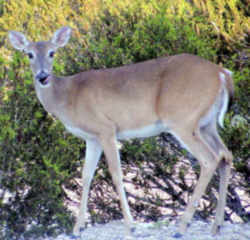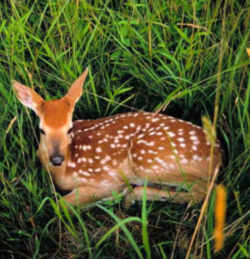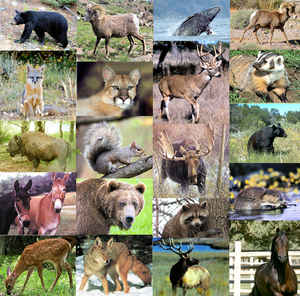
Oklahoma Symbols
Oklahoma State Game Animal
White-tailed Deer

(Odocoileus virginianus)
Adopted on January 30, 1990.
The white-tail deer was adopted as Oklahoma's "official game animal of the State of Oklahoma" by Senate Concurrent Resolution No. 24 (SCR24). The white-tailed deer, Odocoileus virginianus, is a large, brown animal found throughout Oklahoma. Deer prefer to live near forests and agricultural areas, such as crop fields, because these areas provide food and cover for them. Deer have hooved feet, slender bodies, and long, thin legs. Don't let their skinny legs fool you. Deer are able to run up to 40 miles per hour, jump 9 foot fences, and swim at 13 miles per hour.
States that have named the White-tailed deer (Odocoileus virginianus) as their official state mammal and/or animal:
Arkansas | Illinois | Michigan
Mississippi | Nebraska | New Hampshire
Ohio | Oklahoma | Pennsylvania | South Carolina | Wisconsin
Oklahoma State Game Animal: White-tailed Deer
Common Names
White-tailed deer; whitetail deer; Columbian white-tailed deer; Key deer; Coues deer; Texas white-tailed deer; sandhill deer; common deer; jumping deer; flag-tailed deer; bannertail; long-tailed deer; Virginia white-tailed deer; Virginia deer
Characteristics of the White-tail Deer

Head and body length is 150 to 200 cm, tail length is 10 to 28 cm, and height at the shoulders is between 80 and 100 cm.
Odocoileus virginianus dorsal coloration differs in shading locally, seasonally, and among subspecies; however in general it is grayer in the winter and redder in the summer. White fur is located in a band behind the nose, in circles around the eyes, inside the ears, over the chin and throat, on the upper insides of the legs and beneath the tail. Whitetail deer have scent glands between the two parts of the hoof on all four feet, metatarsal glands on the outside of each hind leg, and a larger tarsal gland on the inside of each hind leg at the hock. Scent from these glands is used for intra-species communication and secretions become especially strong during the rutting season. Males possess antlers which are shed from January to March and grow out again in April or May, losing their velvet in August or September. At birth, fawns are spotted with white in coloration and weight between 1.5 and 2.5 kg. Their coats become grayish lose their spots by their first winter. Whitetail deer have good eyesight and acute hearing, but depend mainly on their sense of smell to detect danger.
Natural History
Food Habits
Whitetail deer feed on a variety of vegetation, depending on what is available in their habitat. In eastern forests, buds and twigs of maple, sassafras, poplar, aspen and birch (to name a few) are consumed, as well as many shrubs. In desert areas, plants such as huajillo brush, yucca, prickly pear cactus, comal, ratama and various tough shrubs may be the main components of a whitetail's diet. Conifers are often utilized in winter when other foods are scarce. Whitetail deer are crepuscular, feeding mainly from before dawn until several hours after, and again from late afternoon until dusk.
Reproduction
Most whitetail deer (particularly males) mate in their second year, although some females occasionally mate as young as seven months. Bucks are polygamous although they may form an attachment and stay with a single doe for several days or even weeks until she reaches oestrus. Does are seasonally polyoestrous and usually come into heat in November for a short twenty-four hour period. If a doe is not mated, a second oestrus occurs approximately 28 days later. Mating occurs from October to December and gestation is approximately 6 and a half months. In her first year of breeding, a female generally has one fawn, but 2 per litter (occasionally 3 or 4) are born in subsequent years. Fawns are able to walk at birth and nibble on vegetation only a few days later. They are weaned at approximately six weeks. Life span in the wild is 10 years, but whitetail deer have lived up to 20 years in captivity.
Behavior
Whitetail deer are the most nervous and shy of our deer. They wave their tails characteristically from side to side when they are startled and fleeing. They are extremely agile and may bound at speeds of up to 30 miles per hour through tangled terrain in a forest. Whitetail deer are also good swimmers and often enter large streams and lakes to escape predators or insects or to visit islands. Their home ranges are generally small, often a square kilometer or less. Whitetail deer do not migrate to a winter range but yard up in their own territories during heavy snow. They are notorious for continually using the same pathways when foraging, but will not bed down during the day in areas that they have used previously.
Whitetail deer are generally considered solitary, especially in summer. The basic social unit is a female and her fawns, although does have been observed to graze together in herds of up to hundreds of individuals. Females generally follow their mothers for about two years, but males leave the group within the first year. Bucks may form transient groups of 2-4 in the summer, but these disband prior to the mating season. Males begin rutting as early as September, and at this point become entirely preoccupied with obtaining matings. They do not guard harems (as with elk) but rather fight each other individually, clashing antlers to gain access to a particular female.
Whitetail does are painstakingly careful to keep their offspring hidden from predators. When foraging, females leave their offspring in dense vegetation for about four hours at a time. While waiting for the female to return, fawns lay flat on the ground with their necks outstretched, well camouflaged against the forest floor. Fawns withhold their feces and urine until the mother arrives, at which point she ingests whatever the fawn voids to deny predators any sign of the fawn.
Whitetail deer are not especially vocal, although young fawns bleat on occasion. Injured deer utter a startlingly loud "blatt" or bawl. Whistles or snorts of disturbed whitetails are the most commonly heard sounds.
Habitat
Whitetail deer are able to survive in a variety of terrestrial habitats, from the big woods of northern Maine to the deep saw grass and hammock swamps of Florida. They also inhabit farmlands, brushy areas and such desolate areas of the west such as the cactus and thorn-brush deserts of southern Texas and Mexico. Ideal whitetail deer habitat would contain dense thickets (in which to hide and move about) and edges (which furnish food).
There are 16 subspecies of white-tailed deer in North America. Subspecies are distinguished by geographic location, body size, coloration, antler growth, and physiological, biochemical, and behavioral differences .
Scientific name
The genus name Odocoileus is from the Greek words odon (tooth) and koilos (hollow) or "hollow tooth," in reference to the depressions in the crown of the molar teeth. The Latinized species name virginianus (of Virginia) refers to the state from which the species was first collected and described.
Oklahoma Concurrent Resolution 24
Senate Concurrent Resolution No. 24
A Concurrent Resolution proclaiming the "white-tail deer" as the official game animal of the State of Oklahoma; and directing distribution.
WHEREAS, the white-tail deer is the greatest trophy among Oklahoma's bountiful hunting harvest; and
WHEREAS, the white-tail deer population is estimated at some 250,000 existing in each of Oklahoma's 77 counties; and
WHEREAS, the white-tail deer is the most beautiful and prized symbol of Oklahoma wildlife; and
WHEREAS, the 377,000 resident and nonresident sportsmen who hunt for the white-tail deer and other game during the various seasons make an enormous
contribution to Oklahoma's recreational economy in the amount of $177 Million.
Now, Therefore, be it resolved by the Senate of the 1st Extraordinary Session of the 42nd Oklahoma Legislature, the House of Representatives concurring
therein:
THAT the "white-tail deer" is hereby designated as the official game animal of the State of Oklahoma.
THAT a copy of this resolution be distributed to the Governor, the Lieutenant Governor and the Chairman of the Wildlife Conservation Commission.
Adopted by the Senate the 25th day of January, 1990.
Adopted by the House of Representatives the 30th day of January, 1990.
Filed with the Secretary of State January 30, 1990.
Oklahoma Law
The Oklahoma State Legislature named the white-tail deer Oklahoma's official state game animal by concurrent resolution and it is, therefore, not listed in the Oklahoma Statutes.
Taxonomic Hierarchy: White-tailed Deer
Kingdom: Animalia
Phylum: Chordata
Class: Mammalia
Order: Artiodactyla
Family: Cervidae
Subfamily: Capreolinae
Genus: Odocoileus
Species: O. virginianus







